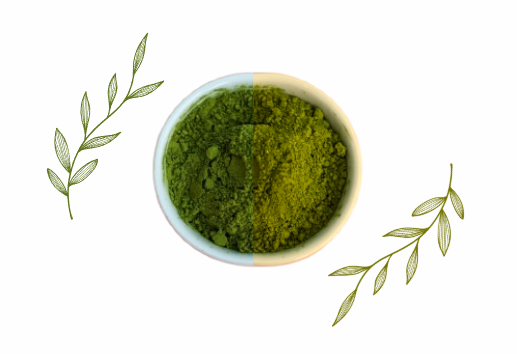Matcha Latte or even traditional Matcha tea is becoming an increasingly popular beverage. There are many types of this green powder on the market, but we can primarily divide it into Japanese and Chinese varieties. What are the differences between these types of Matcha, and which one should you choose? If you want to know the answer, keep reading. We will focus on the differences and tips on what to look out for when selecting high-quality Matcha.

History of Matcha
Matcha is most often associated with Japan, but China was the true cradle of Matcha. Let’s clarify this a bit. When a Buddhist monk returned from his studies in China, he brought tea seeds to Japan and introduced the so-called “way of tea.” What does this mean? It refers to the perfect preparation of tea, which is specific to Japanese Matcha. The tea cultivated for ceremonies was, according to the custom of the time, ground into powder and then whisked into boiling water with a bamboo whisk, where the tea leaves suspended in frothy water were sipped rather than strained, as in steeped tea.
The name Matcha originated from the combination of the Japanese words matsu, meaning “to rub, spread, paint,” and cha, meaning “tea.” Japanese Matcha is grown under strict regulations. Although Matcha originated in China, Japan produces a higher quality powder than versions made in China or elsewhere.
Currently, studies suggest that in the last 15 to 20 years, China has started producing more of its own Matcha green tea powder under simulated Japanese agricultural conditions. So what are the main differences between Chinese Matcha and Japanese Matcha? Why is there such a difference in prices?
Japanese Matcha vs. Chinese Matcha
As mentioned earlier, Japanese Matcha has a much more complex cultivation method, but that’s not the only difference between these two types.
Cultivation
The cultivation and processing of Matcha are the main reasons for the differences between the two types. Japan places great emphasis on quality. Tea plants are shaded several weeks before harvest, which increases the chlorophyll content and gives the leaves a vibrant green color and sweeter taste. After harvest, the leaves are steamed, dried, and ground using traditional stone mills.
Meanwhile, the Chinese variant is often not shaded, meaning the leaves have a lighter color and a more bitter taste. They are usually pan-dried, which impacts the resulting taste and aroma.
Color and Texture
If you were to look at these two types side by side, you would immediately notice the difference. Authentic Japanese Matcha is vividly green, smooth, and above all, silky to the touch. On the other hand, Chinese Matcha generally has a less intense color and is sometimes even yellowish. Its consistency is also coarser compared to the Japanese version.

Taste and Aroma
Matcha from Japan has a distinctively sweet umami taste with little to no bitterness. Thanks to careful processing, it leaves no bitterness. Japanese farmers elevate the quality of their soil to a completely different level, ensuring optimal nutrients for the plants through strict fertilization and irrigation regimes.
What about Chinese Matcha? Its flavor is much more pronounced, often with a bitter aftertaste. Typically, it is not grown in the shade, and the soil does not have the same quality as in Japan, meaning it practically lacks the umami taste and instead has a gritty flavor.
Nutritional Differences
Japanese and Chinese Matcha may contain the same type of beneficial compounds, but those from China simply won’t be in the same quantity or concentration. Research even shows that Japanese Matcha has significantly higher levels of antioxidants, especially L-theanine. Thus, Chinese Matcha has a lower value compared to its Japanese counterpart.
If you’re curious about the effects of Japanese Matcha, check out our previous article: What You Didn’t Know About Matcha Tea: Pregnancy and Effects.
Price Differences
You’ve likely noticed a significant price difference between Japanese and Chinese Matcha. Why is that the case?
Japanese Matcha is more expensive due to the extra work and quality controls, but when you consider the overall picture, do you pay more? If we look at it from a quality perspective, it’s clear that “quality over quantity” means that less Japanese Matcha is needed compared to Chinese Matcha.
Most users who have tried both variants agree that Japanese Matcha is not only more pleasant, but in the long term, it is equally or even more cost-effective. The old saying “you get what you pay for” holds quite true in the case of Matcha.
_(1).svg)